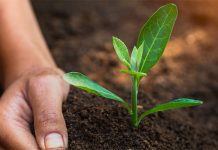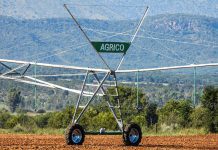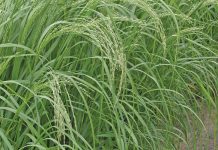Kobus Wessels was recently chosen as the Western Cape Grain SA finalist. Glenneis Erasmus learnt the secret to his farming success: precision, passion and using all available resources to the maximum.
Perfectionism combined with a passion for farming – this is the recipe for the farming success of Kobus Wessels, Grain SA finalist for the Western Cape. “There’s no room for mediocrity or sloppiness if you want to remain sustainable under the current production environment.“ “I aspire to do things right the first time round,” Kobus says, as he searches through the stacks of files and books in his neat office for the information that guides his production methods. Kobus’ meticulousness is reflected in everything he does. His 2 000ha of farmland in the Rietpoel district between Riviersonderend and Caledon is covered with the best-looking wheat, canola and peas in the area, and each camp is neatly fenced off. Knowledge is power H is desire to do things right the first time is also reflected in his hunger for new information. Kobus spends up to two hours a day on the internet, reading up on new production developments, research or challenges facing other farmers. e belongs to numerous forums, and his current favourites are John Deere’s Combine Talk Show, Harvesting.com and AgTalk. “My English is maar poor, so don’t contribute that much to the discussions,” he explains. “But read as much as can to learn about the challenges facing producers from other countries and how they’re tackling them.”
He also has 10 weather websites logged under his “favourites”. “I prefer the University of Cape Town’s web page, because their weather forecasts are updated every six hours,” he says. “This is tremendous as it helps me manage spray drift with all the different crops produced on my farms.” Self-sufficient building After intensive research, much of it over the internet, Kobus built his own planter and grain storage facilities. “I simply copied the best features of planters from four different companies to build one that would best suit my production requirements,” he explains. “My favourite feature is its swivelling drawbar, which helps keep the planter straight while planting and applying fertilisers in uneven areas.” The storage facility is an even more impressive feat, as it required a lot of precision and engineering to ensure that the building is strong enough to hold up to 2 700t of wheat. Thanks to the huge amount of steel used to support the structure, the facility cost over R2,2 million three years ago. Kobus is currently building four 270t silos, with drying facilities, which will hopefully be finished by November. These silos will cost him another R1,3 million. “I’m not anti co-ops, but having my own storage facilities gives me more control and allows me to add value by cleaning and sorting my own wheat,” he explains. “Also, most farmers harvest at a soil moisture level of 13% – giving them 230 hours before the harvest must be stored. Thanks to the driers, harvesting time can be almost doubled as the grain can be harvested at a moisture level of 18%. In the past I needed two combines to harvest, but now I only need one.” Ultra-precise soil testing In 2003, Kobus’s quest for perfection led him to precision farming in an effort to optimise production efficiency. A handheld GPS device is used for grid sampling, to indicate exactly where soil samples should be taken. Samples are taken every hectare and used to determine the exact deficiencies at specific points, as well as the amount of stones in each area. Soil sample analysis in the US would also take the soil type into consideration. “I’d love to add this to my soil analysis, because different soil types will have different nutritional requirements,” Kobus says. “But this type of analysis is still too expensive to render it economically viable on my farms.” Technifarm is used to analyse the samples and make recommendations about soil nutrition. Soil pH is adjusted to around 5,5 using various types of lime, according to the chemical constitution of the soil and its physical qualities, texture and the number of stones present. Phosphate is applied variably during the seven-year cash-crop phase of crop rotation, and maintained at 25ppm based on a Bray 1 soil test. Areas below these levels will receive phosphate, while those above these levels won’t allow the levels to drop. No phosphate is applied during the lucerne stage. Finding the fertiliser balance In addition to soil sample results, the crop rotation programme and the impact of conservation farming methods are taken into account during nitrogen application (see box: Mastering crop rotation). Nitrogen is variably applied according to the carbon content of each hectare. A carbon content of 2% is used as a standard. This is the average carbon content of the soils on Kobus’ farms. Kobus has two basic nitrogen recipes for land with this carbon percentage: 50kg/ha of nitrogen for grains after pod plants, and 80kg/ha of nitrogen for grains on land where no legumes were planted. More nitrogen, up to 125kg/ha, is applied to land with low carbon levels. GPS is also used to monitor the amount of grain produced, the moisture content and soil contour at specific points during harvest. Kobus has already spent over R750 000 on precision farming, but he feels that the benefits of this type of production have more than justified these initial costs, as it has helped him improve yield and reduce input costs. However, some land will remain marginal no matter how much fertiliser is used on it. Kobus uses less fertiliser on these lands. “You need to find a balance between input and output,” he explains, “Nobody knows what the commodity price is going to be at harvest time and a farmer therefore needs to keep his inputs as low as possible. But this doesn’t mean he must be stingy and save himself detrimentally by not applying enough fertiliser on marginal lands.” Technology plus know-how Autosteere is another aspect of precision farming incorporated on the farms and is used on all farm implements. Kobus estimates it has reduced his spraying costs by 7,1%. Autosteere helps reduce driver fatigue, which means that drivers can pay full attention to their work and can work longer hours without much strain. Also, Kobus always keeps a PDA with built-in GPS with him. This allows him to record problems and observations as he encounters them. These recordings are then electronically transferred to his office computer. The dictaphone facility is also very helpful, especially when he is driving implements. What makes Kobus’ liberated use of modern technology even more significant is the fact that this highly-successful farmer only has matric. “My father has been my biggest inspiration and teacher,” he says. “He was the perfect farmer as far as his foresight, dedication to precision, innovation and humility were concerned. Everything else I know, I’ve learnt from other people and taught myself, with the help of various resources.” “The bottom line, however, is that we are living in a modern age and you need to make use of all the technology and all the information you can get hold of if you want to remain sustainable,” Kobus concludes. Contact Kobus Wessels on (028) 261 1922 or e-mail [email protected]. |f
Farming smart and thorough
Kobus Wessels was recently chosen as the Western Cape Grain SA finalist. Glenneis Erasmus learnt the secret to his farming success: precision, passion and using all available resources to the maximum
Issue date 5 October 2007








